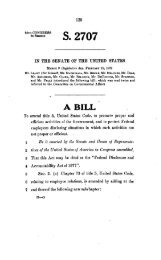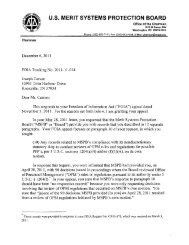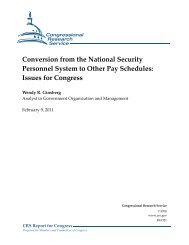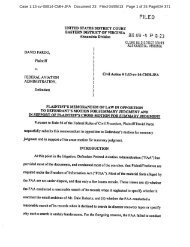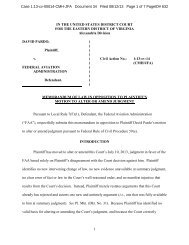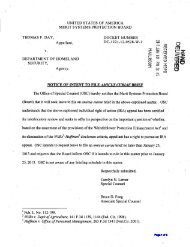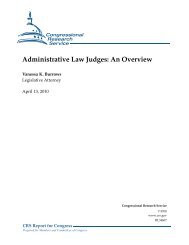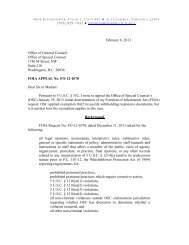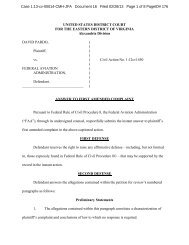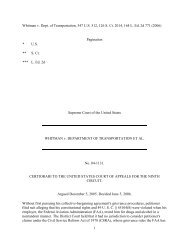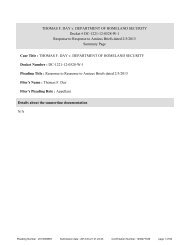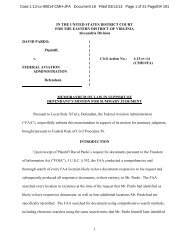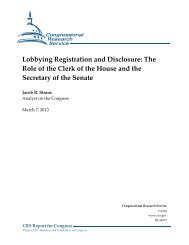The Fair Labor Standards Act (FLSA): An Overview - MSPB Watch
The Fair Labor Standards Act (FLSA): An Overview - MSPB Watch
The Fair Labor Standards Act (FLSA): An Overview - MSPB Watch
Create successful ePaper yourself
Turn your PDF publications into a flip-book with our unique Google optimized e-Paper software.
<strong>The</strong> <strong>Fair</strong> <strong>Labor</strong> <strong>Standards</strong> <strong>Act</strong> (<strong>FLSA</strong>): <strong>An</strong> <strong>Overview</strong>operated by the parent. But, youth under 18 cannot be employed in mining or manufacturing,including in a business owned or operated by a parent. 58Youth under a certain age cannot work in occupations determined by the Secretary of <strong>Labor</strong> to behazardous to minors. <strong>The</strong> minimum age to work in hazardous occupations in nonagriculturaloccupations is 18. In agricultural occupations, the minimum age is 16.<strong>The</strong> <strong>FLSA</strong> also provides exemptions from the limits on employment in hazardous occupations. Inagriculture, youth between the ages of 14 and 15 may work in certain hazardous occupations ifthey are student learners. 59 Minors ages 14 and 15 can operate tractors or other machinery if theyhold a certificate of training from a 4-H or vocational agriculture training program. <strong>The</strong>restrictions on employment in hazardous occupations in agriculture do not apply to youthemployed on farms owned or operated by a parent.Youth ages 12 and 13 can work in agriculture with the written consent of their parents on a farmwhere a parent (or person standing in the place of a parent) is also employed.Youth who are covered by the <strong>FLSA</strong> and are not exempt must be paid at least the applicablefederal or state minimum wage. However, employees in agriculture are exempt from the overtimerequirements of the <strong>FLSA</strong>. 60On September 2, 2011, DOL issued a proposed rule to change the regulations that implement thechild labor provisions in agriculture. In the proposed rule, DOL said that “None of the revisionsproposed in this NPRM in any way change or diminish the statutory child labor parentalexemption in agricultural employment” in the <strong>FLSA</strong>. 61 Nevertheless, in response to concernsabout the potential effects of the proposed rule on the parental exemption, DOL announced, onFebruary 1, 2012, that it was going to reconsider the part of the rule dealing with theinterpretation of the parental exemption. DOL said that instead of applying the parentalexemption to farms that are “wholly” owned by the parent (or person standing in place of aparent) the exemption would apply to farms that are “substantially” owned by the parent. Thus,the parental exemption would apply to farms where the parent is a part owner of the farm, apartner in a partnership, or an officer of a corporation that owns the farm if the parent holds asubstantial ownership interest in the partnership or corporation. 6258 Information on the age limits for youth employment are from U. S. Department of <strong>Labor</strong>, Wage and Hour Division,Child <strong>Labor</strong> Requirements in Agricultural Occupations Under the <strong>Fair</strong> <strong>Labor</strong> <strong>Standards</strong> <strong>Act</strong>, Child <strong>Labor</strong> Bulletin 102,available at http://www.dol.gov/whd/regs/compliance/childlabor102.pdf; and U. S. Department of <strong>Labor</strong>, Wage andHour Division, Child <strong>Labor</strong> Provisions in Nonagricultural Occupations Under the <strong>Fair</strong> <strong>Labor</strong> <strong>Standards</strong> <strong>Act</strong>, Child<strong>Labor</strong> Bulletin 101, available at http://www.dol.gov/whd/regs/compliance/childlabor101.pdf.59 A student learner is someone who is enrolled in a vocational education program in agriculture under a writtenagreement that, among other things, ensures that the work of the student is incidental to the training.60 29 U.S.C. 213(b)(12). Employees on small farms are exempt from both the minimum wage and overtimerequirements of the <strong>FLSA</strong>. A farmer who did not employ more than 500 “man days” of labor in any calendar quarter inthe preceding calendar year is exempt from the minimum wage and overtime requirements of the act. A “man day” isany day in which an employee performed agricultural work for at least one hour.61 U.S. Department of <strong>Labor</strong>, Wage and Hour Division, “Child <strong>Labor</strong> Regulations, Orders and Statements ofInterpretation; Child <strong>Labor</strong> Violations—Civil Money Penalties,” Federal Register, vol. 76, September 2, 2011,available at http://www.gpo.gov/fdsys/pkg/FR-2011-09-02/pdf/2011-21924.pdf, p. 54841.62 U.S. Department of <strong>Labor</strong>, Wage and Hour Division, U.S. <strong>Labor</strong> Department to Re-Propose ‘Parental Exemption’ ofChild <strong>Labor</strong> in Agriculture Rule, February 1, 2012, http://www.dol.gov/opa/media/press/whd/WHD20120203.htm.Congressional Research Service 16



